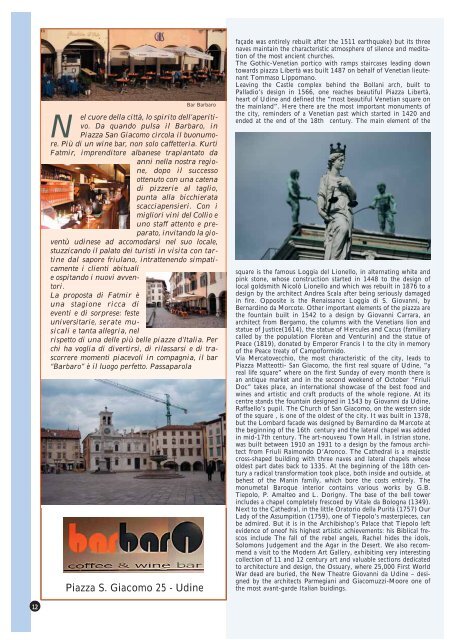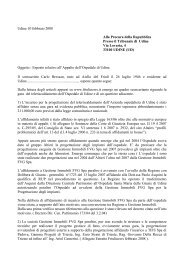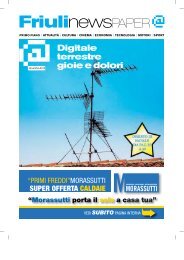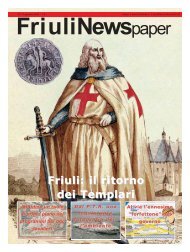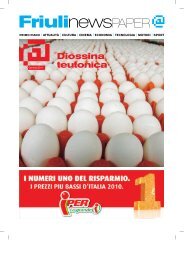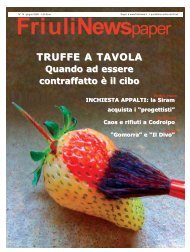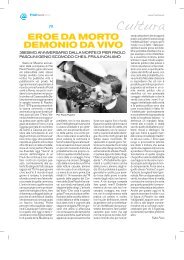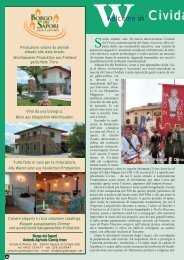die es zu entdecken lohnt - FriuliNews.it
die es zu entdecken lohnt - FriuliNews.it
die es zu entdecken lohnt - FriuliNews.it
Create successful ePaper yourself
Turn your PDF publications into a flip-book with our unique Google optimized e-Paper software.
12<br />
Bar Barbaro<br />
N<br />
el cuore della c<strong>it</strong>tà, lo spir<strong>it</strong>o dell’aper<strong>it</strong>ivo.<br />
Da quando pulsa il Barbaro, in<br />
Piazza San Giacomo circola il buonumore.<br />
Più di un wine bar, non solo caffetteria. Kurti<br />
Fatmir, imprend<strong>it</strong>ore alban<strong>es</strong>e trapiantato da<br />
anni nella nostra regione,<br />
dopo il succ<strong>es</strong>so<br />
ottenuto con una catena<br />
di pizzerie al taglio,<br />
punta alla bicchierata<br />
scacciapensieri. Con i<br />
migliori vini del Collio e<br />
uno staff attento e preparato,<br />
inv<strong>it</strong>ando la gioventù<br />
udin<strong>es</strong>e ad accomodarsi nel suo locale,<br />
stuzzicando il palato dei turisti in vis<strong>it</strong>a con tartine<br />
dal sapore friulano, intrattenendo simpaticamente<br />
i clienti ab<strong>it</strong>uali<br />
e osp<strong>it</strong>ando i nuovi avventori.<br />
La proposta di Fatmir è<br />
una stagione ricca di<br />
eventi e di sorpr<strong>es</strong>e: f<strong>es</strong>te<br />
univers<strong>it</strong>arie, serate musicali<br />
e tanta allegria, nel<br />
rispetto di una delle più belle piazze d’Italia. Per<br />
chi ha voglia di divertirsi, di rilassarsi e di trascorrere<br />
momenti piacevoli in compagnia, il bar<br />
“Barbaro” è il luogo perfetto. Passaparola<br />
Piazza S. Giacomo 25 - Udine<br />
façade was entirely rebuilt after the 1511 earthquake) but <strong>it</strong>s three<br />
nav<strong>es</strong> maintain the characteristic atmosphere of silence and med<strong>it</strong>ation<br />
of the most ancient church<strong>es</strong>.<br />
The Gothic-Venetian portico w<strong>it</strong>h ramps staircas<strong>es</strong> leading down<br />
towards piazza Libertà was built 1487 on behalf of Venetian lieutenant<br />
Tommaso Lippomano.<br />
Leaving the Castle complex behind the Bollani arch, built to<br />
Palladio’s d<strong>es</strong>ign in 1566, one reach<strong>es</strong> beautiful Piazza Libertà,<br />
heart of Udine and defined the “most beautiful Venetian square on<br />
the mainland”. Here there are the most important monuments of<br />
the c<strong>it</strong>y, reminders of a Venetian past which started in 1420 and<br />
ended at the end of the 18th century. The main element of the<br />
square is the famous Loggia del Lionello, in alternating wh<strong>it</strong>e and<br />
pink stone, whose construction started in 1448 to the d<strong>es</strong>ign of<br />
local goldsm<strong>it</strong>h Nicolò Lionello and which was rebuilt in 1876 to a<br />
d<strong>es</strong>ign by the arch<strong>it</strong>ect Andrea Scala after being seriously damaged<br />
in fire. Oppos<strong>it</strong>e is the Renaissance Loggia di S. Giovanni, by<br />
Bernardino da Morcote. Other important elements of the piazza are<br />
the fountain built in 1542 to a d<strong>es</strong>ign by Giovanni Carrara, an<br />
arch<strong>it</strong>ect from Bergamo, the columns w<strong>it</strong>h the Venetians lion and<br />
statue of Justice(1614), the statue of Hercul<strong>es</strong> and Cacus (familiary<br />
called by the population Florèan and Venturin) and the statue of<br />
Peace (1819), donated by Emperor Francis I to the c<strong>it</strong>y in memory<br />
of the Peace treaty of Campoformido.<br />
Via Mercatovecchio, the most characteristic of the c<strong>it</strong>y, leads to<br />
Piazza Matteotti- San Giacomo, the first real square of Udine, “a<br />
real life square” where on the first Sunday of every month there is<br />
an antique market and in the second weekend of October “Friuli<br />
Doc” tak<strong>es</strong> place, an international showcase of the b<strong>es</strong>t food and<br />
win<strong>es</strong> and artistic and craft products of the whole regione. At <strong>it</strong>s<br />
centre stands the fountain d<strong>es</strong>igned in 1543 by Giovanni da Udine,<br />
Raffaello’s pupil. The Church of San Giacomo, on the w<strong>es</strong>tern side<br />
of the square , is one of the old<strong>es</strong>t of the c<strong>it</strong>y. It was built in 1378,<br />
but the Lombard facade was d<strong>es</strong>igned by Bernardino da Marcote at<br />
the beginning of the 16th century and the lateral chapel was added<br />
in mid-17th century. The art-nouveau Town Hall, in Istrian stone,<br />
was built between 1910 an 1931 to a d<strong>es</strong>ign by the famous arch<strong>it</strong>ect<br />
from Friuli Raimondo D‘Aronco. The Cathedral is a maj<strong>es</strong>tic<br />
cross-shaped building w<strong>it</strong>h three nav<strong>es</strong> and lateral chapels whose<br />
old<strong>es</strong>t part dat<strong>es</strong> back to 1335. At the beginning of the 18th century<br />
a radical transformation took place, both inside and outside, at<br />
beh<strong>es</strong>t of the Manin family, which bore the costs entirely. The<br />
monumetal Baroque interior contains various works by G.B.<br />
Tiepolo, P. Amalteo and L. Dorigny. The base of the bell tower<br />
includ<strong>es</strong> a chapel completely fr<strong>es</strong>coed by V<strong>it</strong>ale da Bologna (1349).<br />
Next to the Cathedral, in the l<strong>it</strong>tle Oratorio della Pur<strong>it</strong>à (1757) Our<br />
Lady of the Assump<strong>it</strong>ion (1759), one of Tiepolo’s masterpiec<strong>es</strong>, can<br />
be admired. But <strong>it</strong> is in the Archibishop’s Palace that Tiepolo left<br />
evidence of oneof his high<strong>es</strong>t artistic achievements: his Biblical fr<strong>es</strong>cos<br />
include The fall of the rebel angels, Rachel hid<strong>es</strong> the idols,<br />
Solomons Judgement and the Agar in the D<strong>es</strong>ert. We also recommend<br />
a vis<strong>it</strong> to the Modern Art Gallery, exhib<strong>it</strong>ing very inter<strong>es</strong>ting<br />
collection of 11 and 12 century art and valuable sections dedicated<br />
to arch<strong>it</strong>ecture and d<strong>es</strong>ign, the Ossuary, where 25,000 First World<br />
War dead are buried, the New Theatre Giovanni da Udine – d<strong>es</strong>igned<br />
by the arch<strong>it</strong>ects Parmegiani and Giacomuzzi-Moore one of<br />
the most avant-garde Italian buidings.


